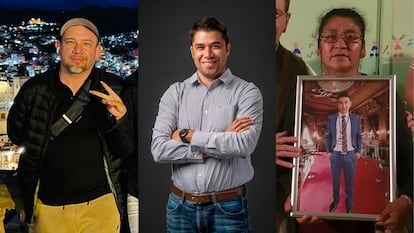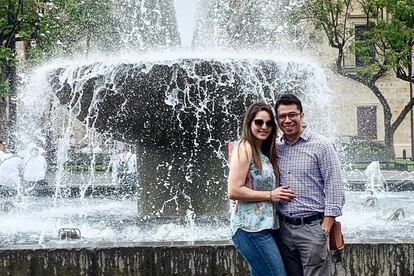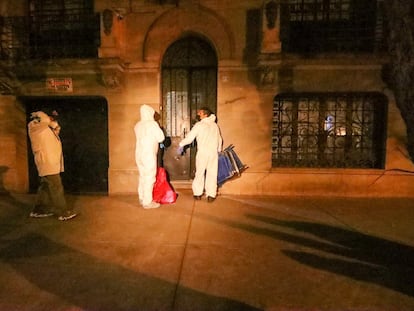Returning to Mexico for a vacation, only to be murdered
José Melesio, César Salazar and Leo Reyes – all residents of the United States – returned to their native country for a few days. They were subsequently abducted and executed. With no suspects in custody, their families are demanding justice

José Melesio was going to marry Daniela Márquez in September. He traveled from Cincinnati, Ohio – where he had lived since he was 12 – to his native Mexico to meet her.
This past December 25, the two of them – along with Daniela’s sister and cousin – disappeared on the highway between the states of Zacatecas and Jalisco. Their bodies were found in a ditch three weeks later.
In June 2021, César Salazar – who was residing in Los Angeles – joined his family in the state of Guanajuato. He was last seen with his cousin, Jorge Enrique Rodríguez, on the Juventino-Celaya highway. Their bodies were found in a grave one month later.
In December 2018, Leonardo Reyes returned to the city of San Miguel de Allende in Guanajuato to celebrate the Day of the Virgin of Guadalupe. At one point, he drove around in his car, looking for a stable signal to call his girlfriend in Dallas, where he worked. A group of state police shot him down.
The three men were 36, 38 and 23-years-old respectively. Of American nationality, they returned to Mexico for vacations. All three were killed. In all three cases, nobody has been convicted – there are not even detainees or suspects. Their families – with whom EL PAÍS has spoken – are asking for justice.
The most recent case of José Melesio has shaken the Mexican community in the United States. Around 12.3 million people born in Mexico live on the other side of the border. Most of them crossed fleeing violence or poverty – many never came back. Melesio’s family settled in Cincinnati in 2010.
José's father, Enrique, says that his son was initially a shy boy, but he later came out of his shell and became the first college graduate in the household. He studied architecture at the University of Miami and, for two years, had been working at an Ohio firm, where everyone is now horrified about what happened to the young man.
“They’ve decided to create a scholarship with my son’s name,” Enrique Melesio tells EL PAÍS by phone. He is in León, in the state of Guanajuato, where the family is now packing their suitcases to return to the US without their son.
The family planned to spend New Year’s Eve in Cancun. José was supposed to meet them on December 28, after spending a few days in Colotlán, Jalisco, where his fiancée lived. But everything fell apart when they got the call.
On Christmas day, José, Daniela, Viviana and Paola were in Jerez de García Salinas, a “magical” town in Zacatecas. One of the small Mexican towns that stands out for its history and architecture, it was about 40 miles from the girls’ house. Late at night, they decided to return to Colotlán.
At 11.11pm, on Federal Highway 23, Daniela Márquez sent a live location to her parents. This was the last time that anything was heard from them. In mid-January, the truck was found, riddled with bullet holes, along with the charred remains of the four occupants.
The main hypothesis points to the likelihood that the youngsters ran into an organized crime checkpoint – the criminals could have been the ones who took them away. In that same area, a fierce battle is being waged between criminal groups. It has already left dozens of towns abandoned, with 17 people having gone missing just in December 2022.

On the night of June 12, 2021, César Salazar – a business representative from Los Angeles – and his cousin, Jorge Rodríguez – a high school teacher – left Guanajuato and took the highway to Celaya. Jorge was showing the state to César, who had lived practically all of his life in the United States.
At one point, on the way back home, they had a flat tire. They pulled up at a gas station in Santiago de Cuenda, at 1.30am on June 13. Jorge’s father and his nephew, Henry, arrived to help them.
In the parking lot, a teenager of around 17-years-old approached them, took a photo of César and Jorge, asked where they were from and spoke to someone over the phone: “It’s them. They say they’re from Yustis. Do you recognize them?”
Someone replied over the line: “No, we don’t recognize them, stop them there.”
The men hurried up – at 2.10am, they finished changing the tire and continued on their way. Later, César and Jorge’s car was intercepted by a truck. Shots were heard. They disappeared.
The families of the victims – accompanied by the Platform for Peace and Justice in Guanajuato, a civic association – sought help from the United Nations. On July 27, 2021, the UN’s Committee on Enforced Disappearances issued an urgent call of action to the Mexican government, asking the authorities to establish a strategy to find the two men.
Three days later, the Guanajuato Prosecutor’s Office announced that it had identified the remains of César Salazar and Jorge Rodríguez through the forensic service.
Raymundo Sandoval – a human rights defender who has been part of the case – explained to EL PAÍS that they “were able to verify that ponchallantas (tire-puncturing mechanisms) were being used on that highway, which is in an area controlled by the Santa Rosa de Lima Cartel.”
“It wasn’t that they were in the wrong place at the wrong time – there was an intention, a strategy. This is what we call the ‘disappearing device,’ which brings together the structure of criminal groups with the omission or complicity of the authorities.”
Leo Reyes, meanwhile, was shot by a tactical group that formed part of the State Public Security Forces (FSPE) on a dirt road. The young man had only been in San Miguel de Allende for a couple of days – his family had left the area seven years previously, to settle legally in the US. They had traveled back because Leo was a great follower of the Virgin of Guadalupe.
He arrived in Guanajuato with his parents. He accompanied them to get an eye exam and helped the women in the town remove stones from the river. The same day, along with 11 other people, he went to buy flower arrangements for the Virgin. The group also burned gunpowder as part of the ceremony.
After participating in a soccer tournament, Leo returned home to his family. He was in a good mood – he had won a ball. He then ate dinner, changed into warmer clothes and drove out into the cold, in search of a stronger signal to talk to his girlfriend on the phone.
His mother, Guadalupe Cayenta, recounts all of this. She concludes: “He didn’t come back.”
Guadalupe’s brother notified her that he had seen some patrols out in the dark. With Leo not having returned, the whole family went out to look for him. Shots were heard. Guadalupe and her daughter-in-law crawled over grass to where the agents and Leo’s vehicle were.
“We were lying down and we were listening to what they were saying. A woman was cursing. ‘Let’s get out of here, nothing’s happening,’ one man said. They were already going to start cordoning off the area and we were lying down – we couldn’t record because we were very close,” Guadalupe recalls over the phone, from San Antonio, Texas. She and her daughter-in-law left as they arrived – with their elbows on the ground.
They continued looking for Leo in the town, in the hospitals and in the sub-prosecutor’s office. On December 13, 2018, Leo Reyes was found dead.
This past September, the family managed to get the case reopened, after it had been closed by the Prosecutor’s Office. The authorities’ version didn’t make sense to the judge. They assured her that Reyes fired at the police first, but the only bullet casings found on the ground belonged to the agents. They told the judge that Leo was accompanied by another person and that they felt threatened – but he was alone. The officers claimed that he died in the “crossfire,” but experts have proven that the young man bled to death from a shot to the back. No policeman called the ambulance to help him: they let him die.
Leo’s mother continues the story.
“They left us dead in life. There are no answers. He was on a dirt road that leads to our ranch, we all know each other here. There’s only one entrance and one exit: what were so many [police] doing here?”
After all these years, Raymundo Sandoval – who has been with the family since the start – points out that the agents “lost control, used firearms without respecting the scale of the use of force. When they realized the abuse, they tried to cover it up.”
Half of the six agents involved no longer work in Guanajuato. None have been removed from their profession, nor prosecuted.
“They were wrong because they thought that no one had seen them, but we were there,” says Guadalpe, who acknowledges that she is now at risk.
“In none of these three cases has there been punishment – this reveals a pattern,” says Sandoval. He points out that, while the deaths of Leo, César and José have gained attention, it’s unknown how many more disappearances have taken place along the highways in Guanajuato or Zacatecas – or how many unofficial executions have been carried out.
“Their cases demonstrate the difficulty of moving freely in Guanajuato, which is experiencing a generalized crisis of insecurity, which has grown over the last five years. Disappearances are the tip of the iceberg of expressions of violence. Lives are being cut short.”
Sign up for our weekly newsletter to get more English-language news coverage from EL PAÍS USA Edition
Tu suscripción se está usando en otro dispositivo
¿Quieres añadir otro usuario a tu suscripción?
Si continúas leyendo en este dispositivo, no se podrá leer en el otro.
FlechaTu suscripción se está usando en otro dispositivo y solo puedes acceder a EL PAÍS desde un dispositivo a la vez.
Si quieres compartir tu cuenta, cambia tu suscripción a la modalidad Premium, así podrás añadir otro usuario. Cada uno accederá con su propia cuenta de email, lo que os permitirá personalizar vuestra experiencia en EL PAÍS.
¿Tienes una suscripción de empresa? Accede aquí para contratar más cuentas.
En el caso de no saber quién está usando tu cuenta, te recomendamos cambiar tu contraseña aquí.
Si decides continuar compartiendo tu cuenta, este mensaje se mostrará en tu dispositivo y en el de la otra persona que está usando tu cuenta de forma indefinida, afectando a tu experiencia de lectura. Puedes consultar aquí los términos y condiciones de la suscripción digital.
More information
Archived In
Últimas noticias
How Japan is trying to avert ‘digital defeat’
From digital curfews to blocking apps: How technology experts protect their children online
Why the price of coffee has skyrocketed: from Brazilian plantations to specialty coffee houses
Confined to a Cuban hospital: When electricity is a matter of life or death
Most viewed
- Pablo Escobar’s hippos: A serious environmental problem, 40 years on
- Reinhard Genzel, Nobel laureate in physics: ‘One-minute videos will never give you the truth’
- Why we lost the habit of sleeping in two segments and how that changed our sense of time
- Charles Dubouloz, mountaineering star, retires at 36 with a farewell tour inspired by Walter Bonatti
- The Florida Keys tourist paradise is besieged by immigration agents: ‘We’ve never seen anything like this’











































